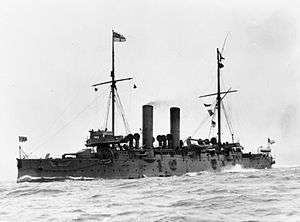HMS Edgar (1890)
HMS Edgar was a first class cruiser of the Royal Navy, and lead ship of the Edgar class. She was built at Devonport and launched on 24 November 1890. She served on the China Station, and in the First World War in the Gallipoli Campaign, along with her sisters Endymion, Grafton and Theseus.
 HMS Edgar | |
| History | |
|---|---|
| Name: | HMS Edgar |
| Builder: | Devonport Dockyard |
| Laid down: | 3 June 1889 |
| Launched: | 24 November 1890 |
| Fate: | Sold for breaking up 9 May 1921 |
| General characteristics | |
| Class and type: | Edgar-class protected cruiser |
| Displacement: | 7,350 tons |
| Length: | 387.5 ft (118.1 m) |
| Beam: | 60 ft (18 m) |
| Armament: |
|
Service history
Edgar was commissioned at Devonport by Captain Ernest James Fleet on 20 February 1900,[1] to take relief crews for the sloops Algerine and Phoenix and the survey vessel Waterwitch, which were recommissioned at Hong Kong for the China Station.[2] A crew for the river service steamer HMS Robin, built at Hong Kong, was also included.[3] She left Devonport on 3 March,[4] and called at Gibraltar, Malta, Aden, Colombo and Singapore, before she arrived at the station headquarters at Hong Kong later that spring.
In April 1902 her boilers were re-tubed due to defects, and after taking part in the Coronation review in August 1902, she was commissioned to relieve Endymion serving on the China Station.[5][6]
She was damaged in an attack by the Austro-Hungarian submarine SM U-29 on 4 April 1918 near position 35°06′N 14°24′E.[7] Edgar was sold on 9 May 1921. She arrived at Morecambe on 24 April 1923 for breaking up.
Notes
- "Naval & Military intelligence". The Times (36071). London. 21 February 1900. p. 10.
- "Naval & Military intelligence". The Times (36055). London. 2 February 1900. p. 10.
- "Naval & Military intelligence". The Times (36062). London. 10 February 1900. p. 9.
- "Naval & Military intelligence". The Times (36081). London. 5 March 1900. p. 11.
- "Naval & Military intelligence". The Times (36724). London. 25 March 1902. p. 9.
- "Naval & Military intelligence". The Times (36756). London. 1 May 1902. p. 6.
- Helgason, Guðmundur. "Ships hit during WWI: Edgar". U-Boat War in World War I. Retrieved 11 November 2008.
References
- Colledge, J. J.; Warlow, Ben (2006) [1969]. Ships of the Royal Navy: The Complete Record of all Fighting Ships of the Royal Navy (Rev. ed.). London: Chatham Publishing. ISBN 978-1-86176-281-8.